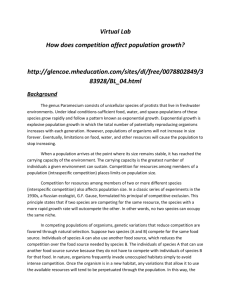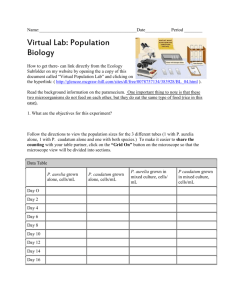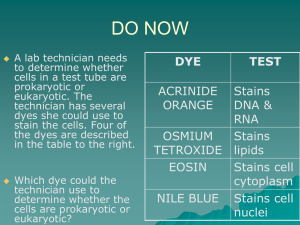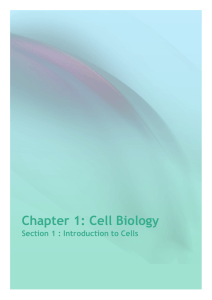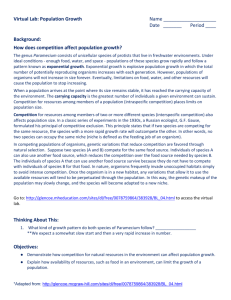Lesson Plan
advertisement
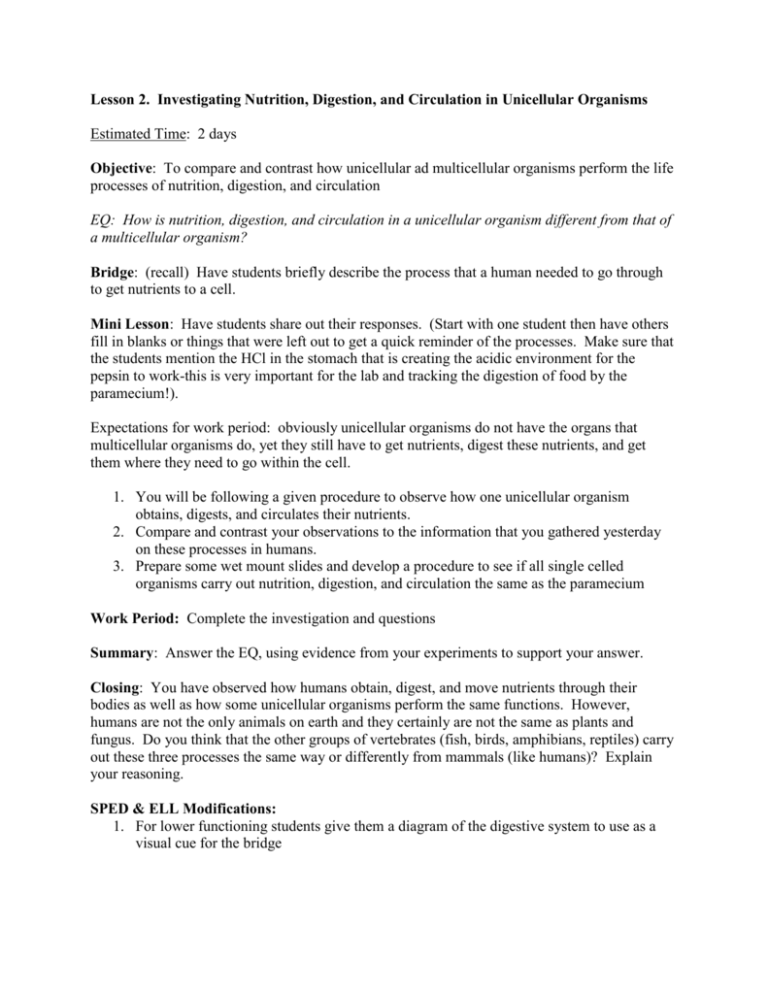
Lesson 2. Investigating Nutrition, Digestion, and Circulation in Unicellular Organisms Estimated Time: 2 days Objective: To compare and contrast how unicellular ad multicellular organisms perform the life processes of nutrition, digestion, and circulation EQ: How is nutrition, digestion, and circulation in a unicellular organism different from that of a multicellular organism? Bridge: (recall) Have students briefly describe the process that a human needed to go through to get nutrients to a cell. Mini Lesson: Have students share out their responses. (Start with one student then have others fill in blanks or things that were left out to get a quick reminder of the processes. Make sure that the students mention the HCl in the stomach that is creating the acidic environment for the pepsin to work-this is very important for the lab and tracking the digestion of food by the paramecium!). Expectations for work period: obviously unicellular organisms do not have the organs that multicellular organisms do, yet they still have to get nutrients, digest these nutrients, and get them where they need to go within the cell. 1. You will be following a given procedure to observe how one unicellular organism obtains, digests, and circulates their nutrients. 2. Compare and contrast your observations to the information that you gathered yesterday on these processes in humans. 3. Prepare some wet mount slides and develop a procedure to see if all single celled organisms carry out nutrition, digestion, and circulation the same as the paramecium Work Period: Complete the investigation and questions Summary: Answer the EQ, using evidence from your experiments to support your answer. Closing: You have observed how humans obtain, digest, and move nutrients through their bodies as well as how some unicellular organisms perform the same functions. However, humans are not the only animals on earth and they certainly are not the same as plants and fungus. Do you think that the other groups of vertebrates (fish, birds, amphibians, reptiles) carry out these three processes the same way or differently from mammals (like humans)? Explain your reasoning. SPED & ELL Modifications: 1. For lower functioning students give them a diagram of the digestive system to use as a visual cue for the bridge 2. For the Mini Lesson: Students can watch the Amoeba eat the Paramecium in this video: http://www.youtube.com/watch?v=pvOz4V699gk&feature=related 3. Students could work with partner to complete the questions during the work period. 4. Pre-record the reading for the independent practice or pair students with reading partners to be able to read the background information for them. Apps and Internet Activities: Youtube App: Students can use the iPads or Netbooks to find two videos of both unicellular and multicellular digestion and MindMeister App: Students can use either iPads or Netbooks as it is a Web2.0 Tool and create comparison charts of the multicellular vs Unicellular digestion (keep in mind for both the 2.0 tool and App students will need to create an account. Popplet App: Could be used to make a comparison chart as well Independent Practice: The background reading provided information on paramecium, including their importance in what was called “detritus- based food webs in aquatic ecosystems”. Using this description and your knowledge of biology, create a food web that has at least 6 organisms in it (one being the paramecium) to show the nutrient/energy flow and interdependence. Paramecium Feeding Lab Tips To make the stained yeast suspension, prepare a thick suspension of yeast that has been mixed with water. Add a small amount of congo red to the yeast suspension. It should be a bright red color. Bring the yeast/congo red suspension to a gentle boil for 5 minutes. Allow the suspension to cool before using in the experiment. Methyl cellulose solution can be purchased or made by adding 3 g of methyl cellulose to 100 ml, of distilled or deionized water. A rich culture of Paramecia will guarantee that students will witness a Paramecium feeding. Good microscope focusing technique and light regulation will be required for this lab. Review these techniques with students prior to the lab. Yeast/Congo red suspension: Add 3 g dry yeast to 10 ml water and stir. Add 0.3 g Congo Red. Boil gently for 10 minutes. This will keep in the refrigerator for a week. This thick solution may be diluted by buffer prior to use. Preparation Notes for this lab: You will have to collect pond water samples for the experimental design section. I did not include an identification key here since the microorganisms you will collect will vary from collection locations and with the temperature. You will need to create this yourself or allow time for the students to find the organisms online (that takes a LOT of time) I usually get my paramecium from the pond water as well, although this is very time consuming to pick them out of the sample (from Mendon Ponds but most creeks or fresh water bodies in the area have tons of microorganisms in them) and I start collecting pond water in August (make my own kids separate out the paramecium) and then culture it in an “artificial pond” which is just a big clear glass jug, throughout the year (same with the Daphnia) but you can order paramecium cultures from Wards or Carolina. To really cut back on time if you planned ahead and have a budget in your school for supplies, you could choose 3-4 different microorganism cultures, mix them together, and throw in some Elodea and just tell the students its pond water **If you are strapped for time/money on this lab, the first part of the yeast digestion can be achieved through this 2 minute video: http://www.youtube.com/watch?v=l9ymaSzcsdY&feature=related And then have them do the guided inquiry lab piece (second part) only. Name ________________________________________________________ School Living Environment Date ______________________ Digestion in Unicellular Organisms Background Information: Paramecia (singular: paramecium) are a slipper shaped ciliates which is found in oxygenated aquatic environments feeding near vegetative matter. Paramecia are unicellular microorganisms belonging to the protoctist phylum Ciliophora. Members of this phylum (ciliates) are characterized by their external covering of continuously beating, hair-like cilia. Cilia are motility organelles homologous to the undulating tails of sperm cells and the epithelial cilia which line our respiratory tracts: they help the paramecia to move. These single celled organisms must perform all of the same functions as a multicellular organism without specialized cells found in multicellular organisms, and it is their ability to fulfill these requirements along with their elaborate cell parts, making them among the most functionally complex cells. Viewed through a microscope you can see many structures the paramecium use to perform these life functions. The buccal cavity, or oral region, is located toward the anterior of the cell. This orifice (opening) is lined with highly organized rows of beating cilia which draw food particles into the cytopharynx (equivalent to the throat of the cell) where they are incorporated into food vacuoles and digested. Also visible within the cytoplasm are two, large, sporadically contracting vacuoles at either end of the cell. The contraction of these vacuoles expels water from the cell as a means of balancing its salt concentration. Paramecia are a key link in detritus-based food webs in aquatic ecosystems. Most paramecia are bacteriovorous and feed voraciously on bacteria that accompany decaying organic matter. These bacteria-gorged cells are then consumed by other protists and small animals, which are in turn preyed upon by larger organisms. The oldest reported fossil Paramecium was discovered in a piece of amber dating back to the Cretaceous period, over 65 million years ago. Question: How does a paramecium get food from its environment and how does it break the food into nutrients? Prediction/Hypothesis: Experimental Design: Materials Paramecium culture coverslips yeast culture microscope Methyl cellulose solution (3%), cotton fibers (pulled from a cotton ball is fine) or Protoslo microscope slides Congo red (stain and indicator for this lab) Procedure: 1. Prepare a stained yeast suspension by adding a few drops or 0.3g of Congo Red to the yeast suspension. Boil the yeast and Congo red for approximately 10 minutes and allow to cool before adding this to the paramecia on your slide. (you may want to do this the day before the lab or your instructor may have done this for you already) 2. Place a ring of methyl cellulose or cotton fibers on a clean microscope slide. 3. Place a small drop of Paramecia culture in the center of the methyl cellulose ring or on cotton fibers. 4. Add a small drop of stained yeast suspension to the Paramecia drop. 5. Cover with a clean coverslip and immediately observe with a microscope. 6. Locate a Paramecium and observe what happens to the stained yeast cells. The Paramecia will ingest some of the yeast cells very quickly, perhaps within 10 seconds of adding the yeast. 7. Study the food vacuole formed inside a Paramecium and observe it for at least 10 minutes. Hint: You will have to continuously focus up and down "through" the Parameciumand regulate the light carefully. 8. Record the color of the ingested yeast in your data table every two minutes for a total of 10 minutes. 9. Draw a sketch of the Paramecium and show the path of the ingested yeast and include & label the nucleus, cell membrane, oral groove, food vacuole, and cilia in your sketch (see the diagram in the background information for help if needed). Data Create a data table for your results. Use your procedure and your question to help you figure out what you should include. With your data, consider the following questions (especially when moving to the data analysis section!): Paramecium Sketch: How is the yeast different from the Paramecium? How did the yeast cells get to the inside of the Paramecium? What color and shape were the yeast cells initially? What does the color tell you about the pH? About how long does it take for the food vacuole to cycle through Paramecium? Was there any change in the shape of the yeast cells over time? What was it? Was there any change in color of the yeast cells over time? What does the change in color, if any, tell you? Data Analysis Evaluation How does digestion in the paramecium compare to what we saw yesterday in multicellular organisms? Design an experiment to see if ALL unicellular organisms carry out these three life functions the same as the paramecium does. Use your lab template for recording purposes. You will find multiple unicellular organisms in the pond water samples you will be drawing from. Use the picture key and characteristics that you observe to figure out what unicellular organism(s) you are looking at.

